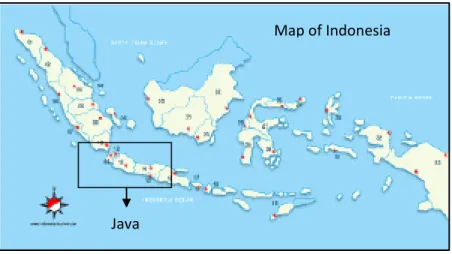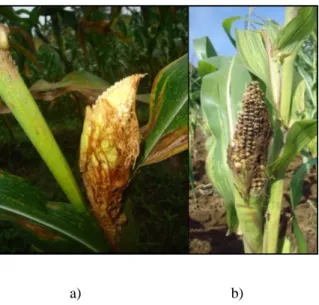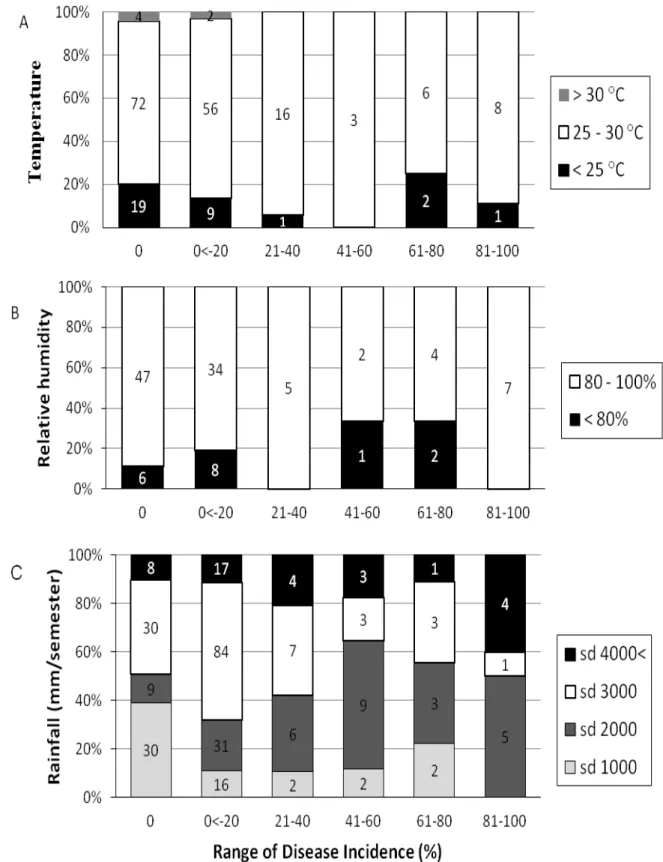ISSN 2307-4531 (Print & Online)
http://gssrr.org/index.php?journal=JournalOfBasicAndApplied
---
Ecological Characteristic of Peronosclerospora maydis in
Java, Indonesia
Ummu S. Rustiani
a*, Meity S. Sinaga
bSri H. Hidayat
b, and Suryo Wiyono
ba
Applied Research Institute of Agricultural Quaratine(ARIAQ), Jl. Raya Kampung Utan-Setu, Desa Mekar Wangi, Kec. Cikarang Barat, Kab. Bekasi (17520), Tel/Fax : +6221 82618923, Indonesia b
Plant Protection Department, Bogor Agricuktural University, Jl. Kamper Kampus IPB Darmaga Bogor (16680),Tel/Fax : +62251-8621267, Indonesia a Email: [email protected] b Email: [email protected] b Email: [email protected] b Email: [email protected] Abstract
Peronosclerospora maydis ( java downy mildew) is very detrimental disease of corn in Indonesia. Ecological
character of this disease is limited during last four decades. The prevalence and morphological character of P.
maydis at different geographic and climate were studied. A total of 228 samples to determine prevalence of P. maydis were surveyed in this study from five provinces of Java. Disease incidence and ecological data for each
location were recorded. Morphological character was observed including conidial and coniodiophore measurement suporting Identification of the causal fungi. Identification based on morphological characther of conidium showed that 68% os samples identified as P. maydis. The most prevalence of JDM based on disease incidence in Java, highly occured in area with temperature range of 25-30 °C, relative humidity 80-100%, and 1000-3000 mm annual rain fall. P. maydis was found frequently in corn at low altitude (0-500 m asl), vegetative stadia of corn, and alluvial soil type.
Keywords: java downy mildew; low altitude; alluvial
--- * Corresponding author.
E-mail address: [email protected]
1. Introduction
Peronosclerospora maydis, the causal fungi of java downy mildew (Java DM), is the most destructive disease
on corn in Indonesia since the past untill now [8,17]. Reports of main disease of corn in Indonesia from 1892 to 2002 still mentions that Java DM become a serious problem in corn production (8). Java DM recently investigated as economic disease of corn causing yield losses 50 – 80% in the central production of East Java, Sidrap (South Sulawesi), and West Kalimantan [2, 11, 12, 14]. Disease incidence observed by the first author in January and February 2013 in area of West and East Java showed that 20-30 days old susceptible cultivars of corn estimated incidence at more than 90%. The incidence decrease at 10% in the age of more than 70 days old.
The past causal fungi of Java DM in Indonesia reported morphologically as P. maydis. Further study stated that
P. philippinensis and P. sorghi also have been reported as the causal fungi of corn DM in Indonesia. Disease
mapping recently had been done during 2002 to 2011 at 8 provinces in Indonesia give limited information of disease prevalence based on ecological characteristic [17, 4, 14]. Semangun reported ecological data of Java DM completely in his desertation in 1968. Ecological data recorded that this downy mildew frequently occured in low land and not found in high land (more than 900 m asl). Current report of ecological character of Java DM was done in artificial condition. Temperature range of germinated conidia artificially optimized at 18-30 °C [ 13, 9]. Optimum temperature range for germination of P. maydis also have been resulted from other study is about 12-20 °C. This range temperature is relatively narower than P. sorghi and P. phillippinensis [10].
Distinction in the result of temperature range and limited information of ecological character of Java DM has provoked conducting study. Study for disease prevalence together with ecological record is highly required to support contol strategy efficiently. Diseasse incidence based on geographic altitude was studied according to adequate control for causal agent of Java DM.
2. Materials and Methods
2.1. Survey Method.
The area covered in the surveys lies between 1° and 9° south latitude and 104° and 114.4° longitude east (Figure 1). Samples of symptomatic infected downy mildew plants taken from five provinces in Java including Banten, West Java, Yogyakarta, Central Java, and East Java. Samples were taken at minimum 30 location of each province by using line transect method. Each sample was observed of symptoms, incidence of disease percentage, type of cultivars, plant age, and information relating to the history of the disease and crop management techniques. Ecological data including altitude (m asl), temperature, rainfall, annual relative humidity, and soil types were recorded for each sample point. The soil type data obtained from the Soil Research Institute, Bogor. Altitude range consists of three criteria i.e lowland (altitude <500 m asl), medium (500-700 m asl), and high (> 700 m asl). Disease incidence was calculated based on the number of symptomatic downy mildew plants in any predetermined transect lines divided by the number of plants observed multiplied by one hundred percent. The third leaves should be cut to get artificial sporulation induction [3] and identified by using morphological characteristic.
Figure 1. Map of Indonesia showing area covered in Java Island (box) in surveys caried out in January and July 2013 to asses disease incidence of Java DM
2.2. Sporulation Induction Method of Java DM
Leaves of infected downy mildew corn in the vegetative stage taken from the field. Leaves of plants selected as sample is third leaf from top of the plants showing symptoms of DM and visible conidial mass white flour liked on the leaf surface. The leaves are cut at the base, then put it in plastic bag clip. Wash the leaf with running tap water by rubbing the leaves with two fingers while flushing the tap water to get leaves stomata clean. Washed leave incubated in the room temperature (RT) during 5-6 hours by putting it in a glass with leaf base position and is under 2 % sugar solution at the bottom of the glass as high as 1 cm. The leaves are taken out at 08.00 – 09.00 pm and wiped the wet base of leaves with tissue paper. Put it into plastic bags, then placed outside to catch the air cold with a position above the surface of the leaf facing up and lower leaf surface facing down. After that left leaves outside untill 04.00 am. The plastic bag containing the leaves was taken gently with the same position of the leaves. Then removed leaf and observed with a flashlight directed to the upper leaf surface and under leaf surface facing upward. Flashlight beam direction contrary to the direction of eye gaze . Mass conidia and conidiophore that look like white flour. Harvesting fungus by grabbing using 2-3 cm transparent tape placed on the leaf surface of that have been marked. Prepare a glass object containing a drop of dye solution methylen blue 2% in the middle. Then pressing gently with finger tape, remove the tape from the leaf surface and placed on the appropriate object glass with droplet dye solution. The dye solution is spread evenly into the tape bottom surface by pressing and rubbing the top of the tape from many parts of the blue color towards the less color blue .
2.3. Morphology Identification.
Conidia and coniophore can be observed under light microscopy. Preparation can be stored for long periods by given the nail polish around outskirts of the tape so dye solution is not evaporated quickly. Morphology characters were identified based on the shape and size of conidia and conidiophore. Morphological character of
P. maydis commonly had spherical and subspherical conidia emerged from the bloated conidiophore
dichotomoasly branched 3 to 4 times lenghth 140-500 µm. Diametric of hyaline conidia was lenghth 17-23 x
27-Map of Indonesia
Java
39 µm and germinate by germ tube [ 7, 17, 8, 6, 3].
3. Results and Discussion
The observation of the 228 sample points in five provinces in Java from January to June 2013 based on morphometry and morphology characters showed that 68% of downy mildew symptoms positively associated with P. maydis. This species listed as quarantine pest in some of the countries in Africa, Europe, America and Canada. Geographic distribution of Java DM only reported in Indonesia and Australia [5]. P. maydis known as the causal fungi for indigenous DM from Indonesia. This species establish more than a hundred years and distributed serounding almost all of the islands in Indonesia.
Variation of symptoms of vegetative and generative stage of corn in the field was observed along surveilance. During vegetative stage, the variation symptoms observed include chlorotic symptoms on the leaves venation, chlorotic symptoms formed leaves-fan shape, as well as dwarf symptoms ( Figure 2). In the generative period, symptoms appear on the uncovered cob, and the unfully charged seeds ( Figure 3). Climatic conditions at the sampling locations were determined based on observations of climatological stations around sampling area. Incidence of disease at area dominated by monthly average temperature of 25-30 °C, and relative humidity of 80-100% (Figure 4). The combination of air temperature and high humidity accompanied by dew at night support the development of the disease [8, 14]. The positive association found in all ranges of altitude, however, most common association found in the lowlands. Range of diseases with high incidence ( > 30% ) were also more frequently observed in the lowlands. Temperature and relative humidity (RH) in lowlands found at 28-32 °C and 80-100% respectively. This is consistent with the optimum temperature for germination of conidia at about 30 °C and RH more than 80%. Java DM can be found at 3 point of highland area with more than 1000 m asl. This result had contradiction teory with corelated study showed that Java DM was not found in 900-1200 m asl [8].
Incidence of the disease in surveyed area dominated by the average rainfall 1000-3000 mm per semester (6 months during surveyed area). This is the first record of annual rain fall preferred by Java DM in Indonesia. Previous study for prevalency of Java DM stated that disease incidence more frequently occured in wet season than dry [8] without any information about average of rainfall per year/ semester.
Highly association P. maydis often found in vegetative stage of corn than generative stage, and the alluvial soil types (Table 1). The susceptible period of plant growth stadium is vegetative plants. Vegetative period are very young and suculent culture so it is easy infected by patogen, therefore, at this stage higher incidence of disease found than at generative stage. Unintensived soil more prevalence for disease incidence [8]. Alluvial soil is one type of fertile soil where additional fertilizer treatment maintain the plant well. Nitrogen fertilizer at below recommendation level, may increase the incidence of disease, but treatment of higher silicate fertilizer will reduce the incidence of illness 24.72 to 30.48% [16, 15]. However, further study of effect and mechanism of fertilization percentage and soil type increasing in the incidence of downy mildew is still needed.
There were two escape areas for Java DM, ie. Karawang (West Java) and Kendal (Central Java). Disease
incidence. This is may caused by type of soil and also organic material fertilization as well as the absence of intensive use of pesticides. Soil types in Karawang is marine sediments and in Kendal manifold latosol brown. It is necessary to analyze the physical and biological properties of soil types in order to determine the correlation between its ecological data and incidence of disease. Adequate ecological data is fully required to develop disease forecasting based on climate properties.
a b c d
Figure 2. Various downy mildew field symptom on vegetative stadia of corn; a) systemic chlorotic; b) Chlorotic leaf vein; c) leave-fan shaped and stunting; and d) sign of downy mildew showed the white flour on the
underside of leaves
a) b)
Figure 3. Symptoms of generative stage in the field; a) the cob opened;and b) uncover by seed completely
Figure 4. Domination of average value of Temperature (A), Relative Humidity (RH) (B), and Rainfall (C) to the Disease Incidance observed in Banten, West Java, Central Java, DI Yogyakarta, and East Java during
January – June 2013
points of survey in five provinces in Java-Based Soil Type, Altitude, and Stadia Growth of corn
Character Kind of Values Frequency of Disease Incidence
Soil type Alluvial 35
Andosol 0 Associated (5 variation) 22 Grumosol 21 Complex (8 variation) 13 Latosol 25 Mediteran 17 Podsolik 3 Regosol 19 Altitude <500 m asl 135 500-700 m asl 18 >700 m asl 2
Growth stage of corn Vegetative 103
Generative 52
4. Conclusion
Symptoms of Java DM was observed variably, namely systemic leaf chlorosis, leaves becomes stiff and fan-like shaped. In the field symptoms can be found in several altitude ranges, around 155 out of 228 sample points. Based on morphological observations of conidia and conidiophores, the symptoms are positively associated with
Peronosclerospora maydis. Disease incidence of Java DM found in specific ecological charactristic i.e average
range of temperature 25-30 °C, relatives humidity more than 80%, and 1000-3000 mm rain fall. Java DM also observed frequently in lowland (0-500 m asl), alluvial soil type, and vegetative stage of corn growth. Further asses of prevalence and severity of Java DM based on ecological characteristic in Indonesia required long periode survey conducted to obtain adequate ecological data.
Acknowledgements
The first author would like to thank the Human Resources Agency of Ministry of Agriculture, Indonesian Agricultural Quarantine Agency (IAQA), Applied Research Institute of Agricultural Quarantine (ARIAQ), Agricultural Quarantine Services in Tanjung Priok, Tanjung Perak, Makassar Port, Central Area and East Area of Plant Quarantine Services, and PT Biogene Scientific.
References
[1]A. Haris Talanca, Burhanuddin, and A. Tenrirawe. Uji resistensi cendawan (Peronosclerospora maydis) terhadap fungisida saromil 35 SD (b.a. Metalaksil). In Prosiding Seminar Ilmiah dan Pertemuan Tahunan PEI,
PFI XXI Komda Sul-Sel dan Dinas Perkebunan Pemerintah Provinsi Sulawesi Selatan. 7 Juni 2011; Makassar,
Indonesia: Bidang publikasi dan Seminar ilmiah BALITSEREAL Maros. (1): 119-122. 2012.
[2]Bahtiar and A. Tenrirawe. Ancaman serangan penyakit bulai di kawasan Danau Sidenreng. In Prosiding
Seminar Ilmiah dan Pertemuan Tahunan PEI dan PFI XX Komda Sul-Sel 27 Mei 2010; Makassar, Indonesia:
Bidang publikasi dan Seminar ilmiah BALITSEREAL Maros. pp. 64-74. 2011.
[3]Burhanuddin. Proses sporulasi Peronosclerospora philippinensis pada tanaman jagung. In Prosiding
Seminar Ilmiah dan Pertemuan Tahunan PEI dan PFI XX Komda Sul-Sel 27 Mei 2010; Makassar, Indonesia:
Bidang publikasi dan Seminar ilmiah BALITSEREAL Maros. pp 366-369. 2011a.
[4]Burhanuddin. Identifikasi Cendawan Penyebab Penyakit Bulai pada Jagung Di Pulau Jawa dan Madura.
Superman : Suara Perlindungan Tanaman 1(1):21-26. 2011b.
[5]Cab International. Crop Protection Compendium, “ htpp//www.cabi.org, Dec. 31, 2013 [Nov. 4, 2014].
[6]International Corn and Wheat Improvement Center. Downy Mildew (extended information). “htpps://www.corndoctor.cimmyt.org/index.php. [Aug. 11, 2013].
[7]Donald G. White. Compendium of Corn Diseases. Third Edition. Minnesota : APS Press. 78 pp. 2000.
[8]Haryono Semangun. Penyakit-penyakit Tanaman Pangan Di Indonesia. 2nded. Yogyakarta: Gadjah Mada Univ. Pres.449 pp. 2008
[9]M. Bustaman & Kimigafukuro T. Studies on medium, temperature for germination of conidia and appearance of local symptoms of P. maydis on corn leaves at different seedling stages.
Contr.Centr.Res.Inst.Food Crops. No.63. Bogor: CRIFC. 14pp. 1981.
[10]M.R.Bonde, G.L. Peterson, R.G.Kenneth, H.D. Vermeulen, Sumartini, and M. Bustaman. Effect of temperature on conidial germination and systemic infection of corn by Peronosclerospora species.
Phytopathology 82:104-109. 1992.
[11]Soenartiningsih. Perkembangan Penyakit Bulai (Peronosclerospora maydis) pada Jagung tahun 2008-2009 di Kabupaten Blitar. In Prosiding Seminar Ilmiah dan Pertemuan Tahunan PEI dan PFI XXI Komda Sul-Sel 27 Desember 2011; Makassar, Indonesia:Bidang publikasi dan Seminar ilmiah BALITSEREAL Maros. (1) pp.100-106. 2012.
[12]Soenartiningsih and A.Haris Talanca. Perkembangan Penyakit Bulai (Peronosclerospora maydis) pada Jagung tahun 2008-2009 di Kabupaten Blitar. In Prosiding Seminar Ilmiah dan Pertemuan Tahunan PEI dan
BALITSEREAL Maros. pp.100-106. 2011.
[13]Sudjadi M, Inaba T, and Kajiwara T. Histopathological Studies on Corn Downy Mildew Caused by Sclerospora maydis (Rac.)Butl. Ann.Phytopathol.Soc.Japan 44:142-150. 1978.
[14]Surtikanti. . Penyakit Bulai pada Tanaman Jagung. In Prosiding Seminar Ilmiah dan Pertemuan Tahunan
PEI dan PFI XXI Komda Sul-Sel 27 Desember 2011; Makassar, Indonesia: Bidang publikasi dan Seminar ilmiah
BALITSEREAL Maros. 2012. (1) pp.41-48.
[15]Surtikanti and R. Efendi. Intensitas serangan penyakit bulai pada tingkat takaran pupuk nitrogen. In
Prosiding Seminar Ilmiah dan Pertemuan Tahunan PEI, PFI XXI Komda Sul-Sel dan Dinas Perkebunan Pemerintah Provinsi Sulawesi Selatan. 7 Juni 2011; Makassar, Indonesia: Bidang publikasi dan Seminar ilmiah
BALITSEREAL Maros. 2012. (1)pp.76-78.
[16]Syahrir Pakki. Peranan silikat terhadap serangan penyakit bulai (Peronosclerospora phillippinensis) pada tanaman jagung. In Prosiding Seminar Ilmiah dan Pertemuan Tahunan PEI dan PFI XVIII Komda Sul-Sel 28 Desember 2007; Makassar, Indonesia: Bidang publikasi dan Seminar ilmiah BALITSEREAL Maros. 2008. pp 222-230.
[17]Wakman Wasmo. Penyebab Penyakit Bulai Pada Tanaman Jagung, Tanaman Inang Lain, Daerah Sebaran, dan Pengendaliannya. In Prosiding Seminar Ilmiah dan Pertemuan Tahunan PEI & PFI XVI Komda Sul-Sel 28 Desember 2006; Makassar, Indonesia:Bidang publikasi dan Seminar ilmiah BALITSEREAL Maros. 2006. pp 36-47.


